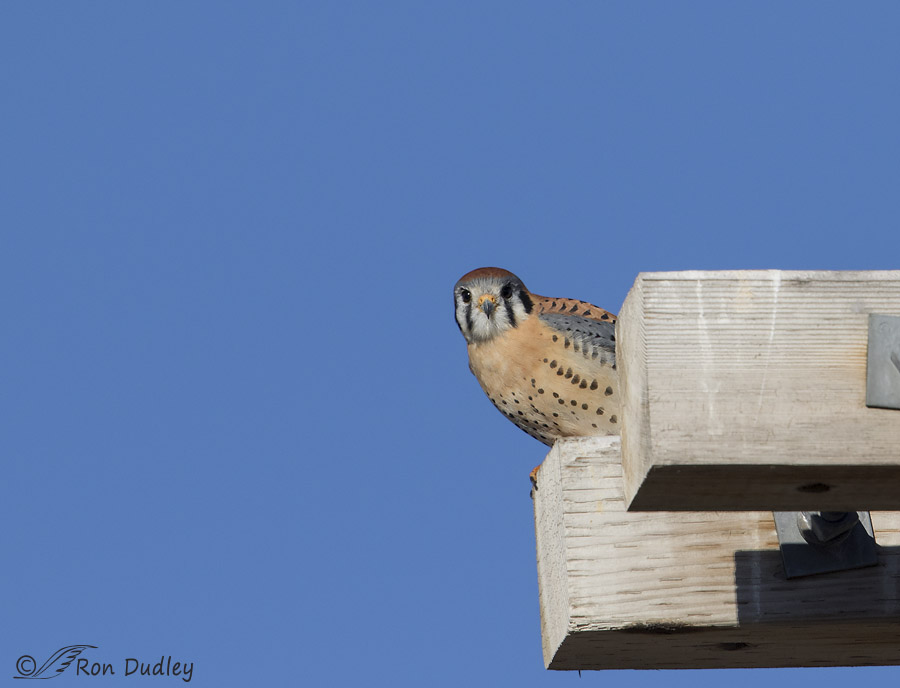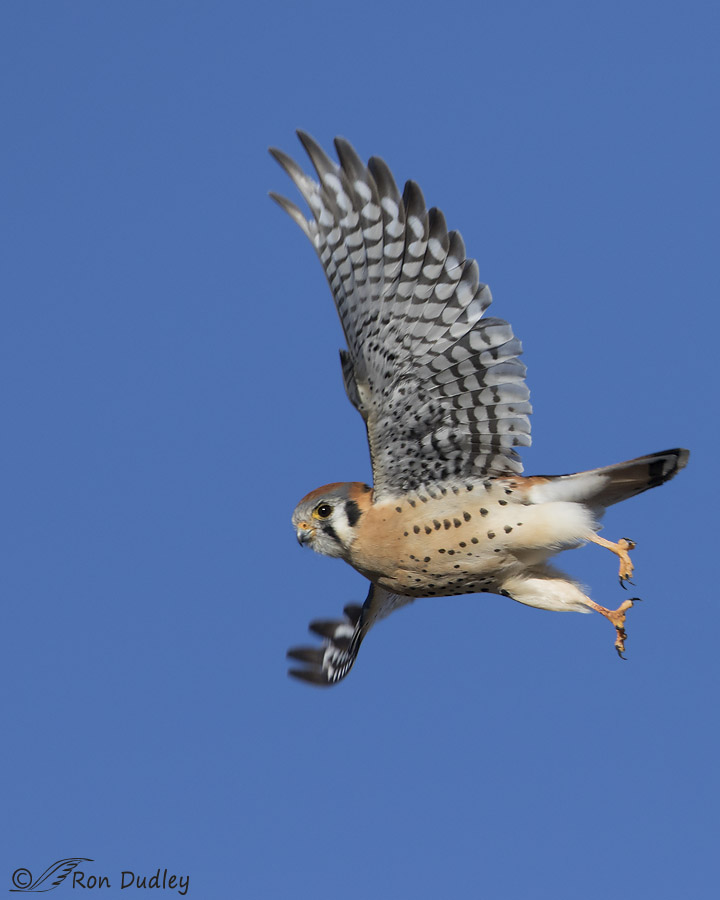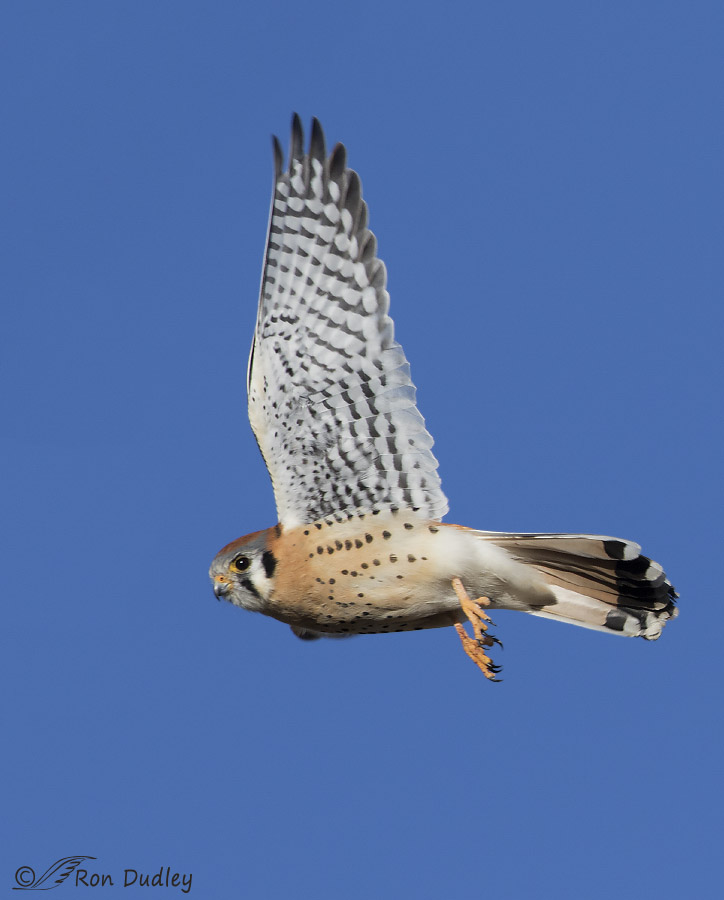Occasionally a situation with low potential can unexpectedly result in a nice flight shot, or even two.

1/2500, f/7.1, ISO 640, Canon 7D Mark II, Canon EF500mm f/4L IS II USM +1.4 tc, not baited, set up or called in
I spent yesterday morning in remote Tooele and Utah Counties in a quest for raptors with moderate success. When I first encountered this male American Kestrel he was cuddling up to his apparent mate on a power pole but compared to the female he was quite shy – soon after I approached he flew a couple of feet to a different part of the pole and hid behind one of the cross beams. He was apparently reluctant to leave his mate and insisted on playing peek-a-boo with me as he mostly hid behind the beam.
I was hoping for take-off shots and figured my chances were best with the female since she was more in the open so I spent most of the time with my lens trained on her, suspecting that the male in his shyness would take off away from me and behind the perch. Ironically I captured the take-off of both birds but I liked the flight shots of the male best.

1/2500, f/7.1, ISO 640, Canon 7D Mark II, Canon EF500mm f/4L IS II USM +1.4 tc, small corner of perch removed, not baited, set up or called in
Usually kestrels give little or no warning before they launch but something in his demeanor told me to put my lens on him and at that moment he took off. I’m reluctant to clone elements out of my images but this perch was ugly and bright so I made an exception in this case and removed a small portion of it.

1/2500, f/7.1, ISO 640, Canon 7D Mark II, Canon EF500mm f/4L IS II USM +1.4 tc, canvas added for composition, not baited, set up or called in
Kestrel take-offs are so fast and explosive that I usually miss the bird entirely or at best clip or cut off body parts but this time I actually got two shots of the entire bird (I can thank the 10 frames/sec burst rate of the Canon 7D Mark II for that). But it was close. The bird was right at the edge of the left frame edge so I had to add a strip of canvas there for composition.
Recently I’ve lamented the low numbers of raptors in my area but this year kestrels seem to be a fortunate exception. I’m seeing more of them than usual in a variety of habitats and many of them already seem to be paired up for spring activities.
I’m delighted to see that hopeful sign for the future.
Ron
Note: There’s been a lot of recent discussion on the web about the ethics of image manipulation (such as the cloning and canvas addition I’ve done here). Occasionally I’ll clone minor elements out of the setting (never into the image) but I don’t alter the bird and I always disclose what I’ve done. IMO, disclosure is paramount. But on the other hand I understand (and don’t necessarily disagree with) the philosophy that any alteration beyond sharpening, tonal adjustments and dust spot removal is questionable in nature photography. It can be a fine line…


Ron, AMKEs are my favorite raptor. I feed a male every Thursday and rarely do I see a photo that is more or almost as attractive to me as he is. These shots are marvelous. Will have to save this post to be able to see it easily whenever I wish to.
Thanks Ron. That helps a lot. I still need to figure out focus tracking and focus lock length so, if anyone uses Nikon and knows how to properly use those for fying birds, please let me know.
Oh WOW!!! The BEST KESTREL SHOTS EVER RON!!!
Charlotte
Hi Ron, I enjoy your wonderful photos and their amazing sharpness. I know equipment has a lot to do with it as well as tecnique and knowledge of the subject but(please excuse my ignorance, I’m fairly new at this)what camera settings do you use to focus and track flying birds? I’m confused with number of focus points active, focus tracking, focus lock length, etc. I know light conditions affect ISO, f-stop, and speed but what do you consider to be the optimums and minimums for each? I’m not even sure which mode to use (aperature, shutter speed, full manual or full auto)! Any help you could provide would be appreciated. Thanks
Larry, I always shoot in aperture priority and I typically use 5 central focus points for birds in flight (sometimes switching to a single active point for perched birds). I nearly always post my image techs under each photo so you can see my settings there. I tend to prefer high shutter speeds because birds are such fast movers(often 1/2500 or faster) but I try to avoid ISO’s above 800 (1600 with my new camera) because of the noise they cause. I talked to Sterling out on the causeway this morning and he told me that you shoot Nikon and since I shoot Canon I’m not sure I can help you much more than that as I’m relatively unfamiliar with Nikon gear and camera lingo.
Ron, sometimes your photo’s just leave me speechless! Kestrels are one of my favorite birds and your images sure do them justice. Thank you. I think they are incredibly beautiful birds.
Who doesn’t admire the beauty of a kestrel, Steve? Thank you.
Ooooh. And ahh.
Thank you.
You’re very welcome, EC.
Look at that bright yellow cere! Ready for breeding! Wonderful shots… always such a joy.
He was certainly “in the mood”, Deborah.
Great catches!!! The explosive, “fling”‘of their take off is really beautifully captured….love the detail….good work!!!
Thanks very much, Patty.
I have to agree with most here and say these are my favorite raptor, these and Merlin’s (I think I got that right?)
Thank you for the great shots, especially the “peep-a-boo” one, just lightens my heart!
Alan
Yep, you got Merlin right, Alan. Thank you.
Beautiful shots of my favorite bird. I especially like the first take off shot – the feather pattern details, the alula on the left wing, and the position of the legs/feet that make it clear he’s just launched. I also like that in all three shots he’s looking straight at you. It’s great that you are seeing more Kestrels this year. Life would be sadder and duller without their feisty little selves around.
“I also like that in all three shots he’s looking straight at you”.
I do too, Susan and that actually surprised me a bit because kestrels seem to usually look away from me when they take off.
That peekaboo shot is so characteristic if my favorite little raptors. Thanks for the lovely pictures to brighten a snowy morning!
I’m glad you enjoyed them, Naomi. Thank you.
My favorite of the raptors is this bird. I love how small they are.
Agreed, Arwen. They’re lovely birds – both sexes.
Very nice shots Ron, just beautiful. Yes Kestrel’s are explosive, haven’t got a decent flight shot yet. Hope to some day, but they are skittish around here for even a perched shot.
Thanks, Dick. They’re usually quite unapproachable around here too.